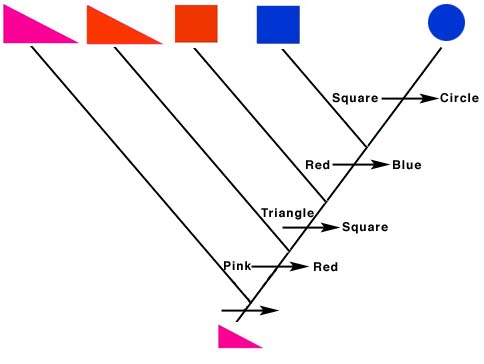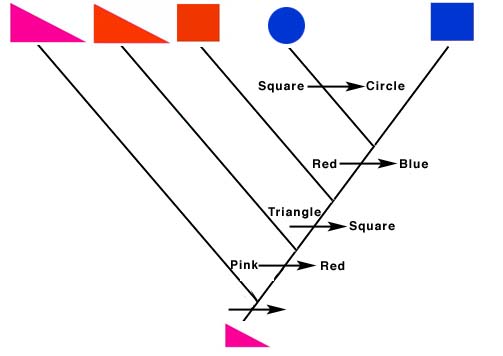
Cladogram using geometric shapes
The students should first decide what the characters and the character states are for the geometric shapes. Once they do that, they can fill out a data matrix. With the data matrix, they can begin to work on the cladogram itself. The teacher may either tell them right away what the ancestor looks like, or have them make assumptions about ancestral states and build the cladogram accordingly. For instance, some students may assume the path of "evolution" for the shapes started with the circle and went to other shapes from there, in which case the circle and the blue square should be at the base of the cladogram; they may decide the evolutionary path started with three-sided shapes and a fourth side is the derived state. Once the ancestor is added, however, there is only one solution for the cladogram. It will look like this:

You might get two questions at this stage:
1. "Can we use the same character over again?"

The above cladogram gives the exact same information and illustrates the exact same relationships as the previous one. However, students will probably prefer to have the squares next to each other, as that makes the evolutionary relationships easier to visualize.
Cladogram using the critters
For the first cladogram exercise on the "How do I do that?" activities page, you will have to assign a hypothetical ancestor so that the students will have a way to determine what is the ancestral character and what is a derived character. For my example, I decided the hypothetical ancestor had hooves and a short neck, and constructed the cladogram accordingly. The data matrix for my character states and the cladogram I constructed may be found here.
With the addition of the fossil information, however, the students will have a way to "polarize" their data. That means that, based on fossil evidence, they can actually determine what direction evolution occurred, what the "primitive" features were, and what the more-derived features look like.
| Home | How do I do that? | What does that mean? | Teacher's Page | Show what you know! | Web Resources |